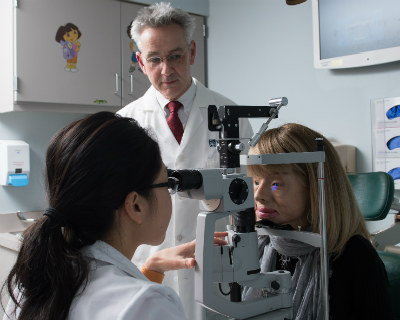To Thomas Steinemann, MD, his patient Andrea Hope Rubin is more than a case of remarkable recovery, she's also one of the most inspirational people he has ever met.
Most people don't survive third and fourth-degree burns affecting 58 percent of their body. Within two months after 49-year-old Andrea Rubin was pulled from a burning car, she had endured some 20 surgeries to save her life. Her right arm was partially amputated, her eyelid reconstructed using skin from her foot. Virtually no part of her body had been spared injury, either burned or harvested for skin grafts. So, when ophthalmologist Thomas Steinemann, MD, told her she should have four or five additional surgeries to save an eye that could no longer see, she pushed back. What was the point? It wouldn't restore her sight, only prolong her painful recovery. She wanted him to remove her badly burned eyeball, give her a prosthetic eye and move on.
But Dr. Steinemann wasn’t ready to give up and move on. He explained that while he couldn't restore her sight with today's technology, it may be possible with future advancements. Plus, it would improve her appearance. She relented, though she was still "crabby" about the decision.
"I owe so much to him," said Rubin, reflecting on her experience four years later. "Dr. Steinemann was so compassionate. I don't know how he talked me into more surgeries, but I'm so grateful he did. I'm happy and incredibly grateful for all that I still have. I am living a more purposeful life than ever before."
To Dr. Steinemann, Rubin is more than a case of remarkable recovery, she's also one of the most inspirational people he has ever met.
A Perfect Storm

Andrea Hope Rubin (right) continues to receive care from Thomas Steinemann, MD, years after her accident.
Rubin has no memory of what happened to her on Oct. 11, 2014. Police reports tell the story of a perfect storm of bizarre events. Her tire got stuck in a divot as she backed out of a parking space. As she struggled to free her car, the tire sparked and the engine caught fire. She passed out as the car filled with deadly carbon monoxide and then the car caught on fire. When firefighters arrived on the scene, the car was engulfed in flames; they couldn't tell there was a person inside. She was immediately transported by a Life Flight helicopter to MetroHealth in Cleveland, where physicians put her in a medically induced coma for about six weeks while they worked to save her life.
Bacterial infection is the most common cause of death among burn victims. As physicians battled against the advancing microbes, they sewed Rubin’s eyelids shut to protect her eyes from a severe fungal infection called Candida tropicalis that threatened to further destroy her eye. But there wasn't enough skin remaining to protect her right eye, so surgeons took a patch of skin from her right foot to fashion a new eyelid. Then they waited for Rubin to recover from the patchwork of skin grafts covering her body.
When she was brought out of the coma, nothing about her physical appearance was familiar. "I had a choice," Rubin explained. "I could curl up and die or I could say, I lived, let's do this right. Is this going to kill you or is this going to make you stronger?"
Living a Good Life
Rubin did get lucky. Even though her left eyelid burned, she could still see in that eye. But the damage to her right eye was more extensive. The cornea, the clear, dome-shaped surface that covers the front of the eye was so damaged, Dr. Steinemann had to remove the tissue and replace it with corneal tissue from a donor.
Typically, a cornea transplant is done to restore sight, but in Rubin's case the transplant was done to prevent infection from creeping into her eye. To provide more protection, Dr. Steinemann performed another procedure similar to a skin graft. He took a section of undamaged conjunctiva, the clear tissue covering the white part of the eye, and placed it over her cornea. Once her eye healed, she was fitted with a special contact lens that covers the entire front of the eyeball, custom-painted to match her other eye.
"Save the eyeball, that's our goal," Dr. Steinemann said. "If we can save someone's eye, we're going to do our best and give them every opportunity for future advancements in eye care. Sometimes the victory is just in saving the eye."
Rubin is grateful Dr. Steinemann saved her eye. Having an eye that moves normally and matches her other eye has improved her appearance. However, one of the surprising lessons she learned from her experience is that how she looks has nothing to do with how she connects with people. She has done some motivational speaking to help spread this hard-won lesson and hopes to do more.
Because the skin on her scalp is fragile, she continues with weekly check-ins at the MetroHealth Burn Care Center, and applies eye drops daily to prevent infection. She has had some 50 surgeries, with more to come. Other than that, Rubin lives a fairly normal life. She runs, lifts weights and lives independently.
Seeing Rubin thrive is an emotional experience for Dr. Steinemann. While hopeful, he didn't really know how well Rubin would recover through all the surgeries and the constant battle against life-threatening infection.
"I'm stronger now than I ever was," Rubin said. "I don't want my story to make people feel sad. I'm happy. I'm living a really good life. So many great things have come from it."